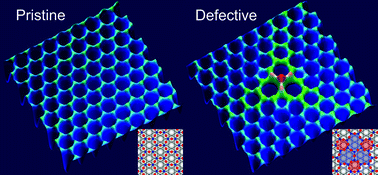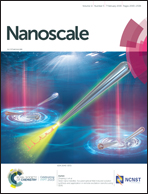Influence of the support on stabilizing local defects in strained monolayer oxide films†
Abstract
Two-dimensional materials with a honeycomb lattice, such as graphene and hexagonal boron nitride, often contain local defects in which the hexagonal elements are replaced by four-, five-, seven-, and eight-membered rings. An example is the Stone–Wales (S–W) defect, where a bond rotation causes four hexagons to be transformed into a cluster of two pentagons and two heptagons. A further series of similar defects incorporating divacancies results in larger structures of non-hexagonal elements. In this paper, we use scanning tunneling microscopy (STM) and density functional theory (DFT) modeling to investigate the structure and energetics of S–W and divacancy defects in a honeycomb (2 × 2) Ti2O3 monolayer grown on an Au(111) substrate. The epitaxial rumpled Ti2O3 monolayer is pseudomorphic and in a state of elastic compression. As a consequence, divacancy defects, which induce tension in freestanding films, relieve the compression in the epitaxial Ti2O3 monolayer and therefore have significantly lower energies when compared with their freestanding counterparts. We find that at the divacancy defect sites there is a local reduction of the charge transfer between the film and the substrate, the rumpling is reduced, and the film has an increased separation from the substrate. Our results demonstrate the capacity of the substrate to significantly influence the energetics, and hence favor vacancy-type defects, in compressively strained 2D materials. This approach could be applied more broadly, for example to tensile monolayers, where vacancy-type defects would be rare and interstitial-type defects might be favored.



 Please wait while we load your content...
Please wait while we load your content...